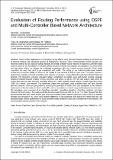| dc.description.abstract | Newer mobile applications are increasingly being defined using Internet Protocol, resulting in increased use
of Internet Protocol and subsequent upsurge of smartphones. However, many communication service provider core
networks continue to use classical routing protocols and single controller-based networks if deployed. Controller-based
networks built on the foundation of software-defined networks include centralization and separation of control plane
and data plane, which can address the challenges experienced with the classical routing protocols. When single
controllers are used, they tend to get overloaded with traffic. The ability to use multi-controller-based network
architecture to improve quality of service in the mobile IP core network is still an open issue. This paper presents a
performance evaluation of multi-controller-based network architecture, running OpenFlow and Open Shortest Path First
protocol. The long-term evolution simulated network architecture is created using well-known network simulator
Objective Modular Network Testbed running OpenFlow and simuLTE add-on. We test and analyze data traffic for
Packet data ratio and Jitter and their associated effects on a multi-controller-based network running OpenFlow versus
OSPF on a mobile core network. The experiment created two topologies; multi controller-based and Open Shortest
path first network. Video and ping traffic is tested by the generation of traffic from User Equipment to the network based server in the data center and back, and traffic metrics recorded on an inbuilt integrated development environment.
The simulation setup consisted of an OpenFlow controller, HyperFlow algorithm, OpenFlow switches, and Open
Shortest Path First routers. The multi-controller-based network improved Jitter by 10 ms. The Open Shortest Path first
showed packet data ratio values of 89% gain while the controller-based network registered a value of 86%. A standard
deviation test revealed 0.7%, which shows that the difference is not significant when testing for Packet data ratio. We
provided insight into the performance of multi-controller-based architecture and Open Shortest Path First protocol in the
communication service provider's core network. | en_US |

